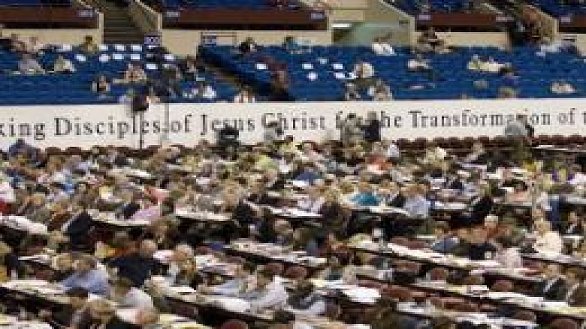When delegates to General Conference meet April 24-May 4 in Tampa, Fla., they will be asked to approve a new structure for the United Methodist Church.
The recommended structural changes come out of the multiyear Call to Action process, which identified a “perceived distance” between general agencies, annual conferences and local congregations.
Proposed structural changes are part of an effort to reduce sense of distance, reduce costs, and strengthening the connection.
A recommendation from the Connectional Table would consolidate 10 of the denomination’s 13 general agencies into five offices that will be part of a new United Methodist Center for Connectional Mission and Ministry:
1. The Office of Justice and Reconciliation would encompass the essential functions of the General Board of Church and Society, and the General Commission on Religion and Race and the General Commission on the Status and Role of Women.
2. The Office of Congregational Vitality would encompass the functions of the General Board of Discipleship and multicultural ministries.
3. An Office of Leadership Excellence would encompass ministries now done by the General Board of Higher Education and Ministry.
4. An Office of Missional Engagement would be responsible for much of the work now done by the General Board of Global Ministries.
5. A fifth office in the new center would deal with shared administrative services that support the work of the other four, including the functions of the General Council on Finance and Administration, United Methodist Communications and the General Commission on Archives and History.
The center, which coordinates the day-to-day work of the five offices would be led by an executive general secretary and a 15-member board of directors. Long-term strategies will be established by a 45-member Council on Strategy and Oversight. That council will have the right to appoint and remove members of the 15 member board of directors of the center.
If the recommendation gains General Conference approval in 2012, the plan calls for the transition to be implemented in two phases over a two-year period.
UM Men to be a separate agency
The General Commission on UM Men is not one the agencies proposed to be subsumed under the new center. The proposal calls for UM Men and UM Women to become separate membership-based boards that raise at least 80 percent of their own monies.
The General Board of Pension and Health Benefits and the General Board of the United Methodist Publishing House would also continue as separate agencies with no World Service funds.
Reduced budgets
The Connectional Table and the General Council on Finance and Administration are proposing a 2013-2016 budget of $603 million. That figure is a 6.04 percent reduction from the previous four years and marks the first time since the 1968 formation of the UMC that a smaller budget will be proposed to General Conference. Other proposed quadrennial budgets increased the dollar amounts, but they did not keep pace with inflation.
In addition, the Connectional Table is proposing a constitutional amendment that will allow any designated agency to make changes in the budget between quadrennial sessions of General Conference. Table members are suggesting $60 million might be reallocated to educate pastors and grow churches in annual conference outside the United States.
Each year of the 2009-2012 quadrennium, the General Commission on UM Men will receive around $340,000. That amount would decline by 6.5 percent in the 2013-2016 quadrennium, and it could decrease by another 10 percent if the budget were to be reallocated after General Conference.
What you can do
Invite your UM Men organization to study and discuss the proposed restructure. Compare the proposed structure with the current structure at www.umc.org.
Discuss the advantages and disadvantages of the proposal. Which groups will benefit and which groups will struggle?
The proposal will reduce costs by dropping some 350 board members and expensive meetings, but what will be lost by having the daily work of agencies supervised by a 15-member board of directors and long-term planning done by a 45-member General Board of Strategy and Oversight?
Share your observations and suggestions with General Conference delegates from your annual conference.


